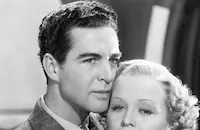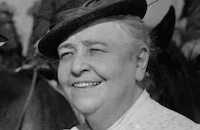White Fang
Brief Synopsis
Cast & Crew
David Butler
Michael Whalen
Jean Muir
Slim Summerville
Charles Winninger
John Carradine
Film Details
Technical Specs

Synopsis
Gordon "Scotty" Scott intends to leave for Seattle, weary of the Klondike. After he says good-bye to his pal, Slats Magee, a woman walks up to him from behind and then indicates that she mistook him for her brother. Scotty assumes that she is a lady for hire. Minutes later, Scotty saves a man from being robbed in an alley, and he is taken to the rescued man's sister Sylvia Burgess, the woman he encountered earlier. Hal Burgess, the rescued man, intends to mine his uncle's claim in Caribou Creek. Scotty tries to dissuade him, but he finally agrees to accompany Hal to the mine in order to convince Sylvia to return to San Diego. On their trip, Hal and Scotty encounter storms, but Hal refuses to go back, although he is haunted by the fabled White Fang, half-wolf and half-dog, and son of the famous dog Buck. Exhausted and hungry, Hal shoots himself, and Scotty collapses. However, White Fang guards Scotty until some men come by and take him to widow Maud Mahoney's trading post in Caribou Creek. She and Doc McFane find Hal's identification on Scotty, a mistake that Scotty does not correct when revived. Slats comes to town, and Scotty convinces him not to expose his true identity. Scotty and Slats take over the Burgess' Gambetta Mine from Beauty Smith, who had been running it illegally. Scotty stops Smith's staged dogfight to save White Fang and begins to domesticate and train him, despite Slats's misgivings about the animal's wild side. In the Spring, Slats and Scotty are about to leave with their earnings, when they are surprised by Sylvia coming to visit. Scotty is exposed, but when he confesses his fraud to her, she decides to hire him as her foreman, which angers Smith. Scotty, however, does not tell her the truth about how Hal actually died. Scotty and Sylvia soon fall in love and plan to marry. Smith, seizing a gold watch to repay the drunken Doc's debts, sees that it was Hal's and learns that Doc found it on a man who was shot to death. Doc indicates that he has other evidence and hides it for safekeeping, but forgets where he placed it. Smith then interrupts the wedding of Scotty and Sylvia and seizes Scotty for Hal's death. However, the crowd insists that Smith wait for the mounted police to arrive before exacting justice. Scotty is imprisoned, but he escapes to tell Sylvia the truth, and Smith helps him to get away in order to recapture and lynch him. Scotty is seized by Smith's men, while Doc, Maud and Slats look for the evidence Doc hid. They find Hal's diary, which indicates that he was going to kill himself, and Maud exposes Smith's plan to take over the mine. Gravely injured defending Scotty, White Fang manages to pull through, thanks to the "strength of the wild." Sylvia and Scotty leave for the South taking White Fang with them, and they watch the dog playing with children on board the ship.

Director
David Butler
Cast

Michael Whalen

Jean Muir

Slim Summerville

Charles Winninger

John Carradine

Jane Darwell

Thomas Beck
Joseph Herrick
George Ducount
Marie Chorre
Lightning

Ward Bond
Ed Thorpe
Steve Clemento
Jack Curtis
Robert St. Angelo
Nick De Ruiz
Desmond Gallagher
Walter James
Jack Stoney
Joe Brown
Stanley Andrews
William Wagner
Heinie Conklin
Buck Connors
Herbert Heywood
Francis Mcdonald
Russ Clark
Bruce Mitchell
Edward Peil Sr.
Crew
Joseph Aiken
Mary Crumley
William Darling
S. G. Duncan
Herbert Farjeon
William Forsyth
Gene Fowler
Roger Heman
Arthur Lange
Thomas Little
Hal Long
Arthur Miller
Eleanor Morra
Irene Morra
Bogart Rogers
Royer
Joseph M. Schenck
Darryl F. Zanuck

Film Details
Technical Specs

Quotes
Trivia
Notes
The opening credits state that the book is "A sequel to The Call of the Wild." Twentieth Century Pictures produced a film version of the earlier novel in 1935. According to information in the Twentieth Century-Fox Produced Scripts Collection at the UCLA Theater Arts Library, Darryl F. Zanuck contributed ideas to at least three story conferences at various stages of the screenplay's development. According to news items, Robert Taylor was originally scheduled for the part of "Gordon Scott," and early in March 1936, John Boles was announced for that role. Because John Carradine was not able to finish his role in Mary of Scotland until 21 Mar, Twentieth Century-Fox rearranged its shooting schedule. New York Times commented that Carradine played "one of the most picturesque and improbable villains seen hereabouts in a long time." New York Times also praised the performance of the dog Lightning stating, "The scene in which he struggles with his dual personality like Fredric March [in Dr. Jekyll and Mr. Hyde] gradually conquering the wolf and succumbing to his dog nature and to the olfactory charm of Michael Whalen, whom he has tracked down in the snow, is one of the most convincing since Dr. Jekyll and Mr. Hyde, and even suggests that masterpiece with a number of toothy, Hydelike close-ups." Jean Muir was loaned from Warner Bros., according to Hollywood Reporter. Although the character of Hal Burgess is clearly meant to have committed suicide by the last sentence of his diary, the word "suicide" or any equivalent is never used in the film. At each point when Hal's fate is brought up, dialogue evades the issue of precisely what happened; Scotty's final explanation of the truth to Sylvia is shown from outdoors through a window. Other films made from the same source include the 1925 R-C Pictures production, distributed by Film Booking Offices of America, directed by Lawrence Trimble and starring Strongheart, Theodore von Eltz and Ruth Dwyer (see AFI Catalog of Feature Films, 1921-30; F2.6295); a 1946 Russian film, a 1973 Italian-Spanish co-production and a 1991 Disney feature, directed by Randall Kleiser and starring Ethan Hawke. In 1946, Twentieth Century-Fox assigned writers to prepare a script for a remake, but that production was never undertaken.












